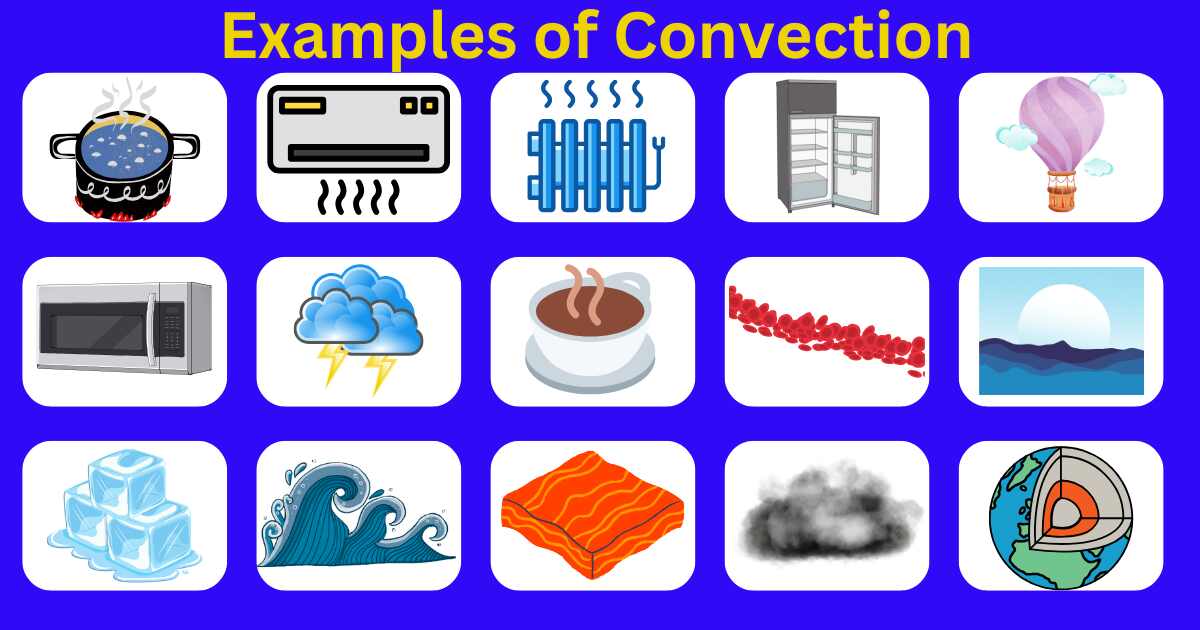Convection heat transfer is part of our everyday life. It helps us cook food and keeps our homes warm or cool. Let’s look at 19 easy examples of convection you can find around you.
What is Convection heat transfer?
Convection heat transfer is the method of transferring heat through the movement of molecules in fluids, like gases and liquids. Initially, heat is transferred between an object and the fluid through conduction. However, the bulk of heat transfer happens as the fluid moves.
This process involves the exchange of thermal energy in fluids due to the movement of matter within them. Convection occurs in both gases and liquids, creating a cyclical pattern.
There are two types: natural convection, which happens without external forces, and forced convection, which involves an external mechanism like a fan or pump.
For example, when a liquid is heated over a hot surface, the lower layers of the fluid warm up and become less dense. These warmer layers rise due to buoyancy, while cooler, denser fluid moves down to take their place. This ongoing process creates the cyclical effect characteristic of convection.
How is Heat Transferred through Convection?
Heat is transferred through convection by the movement of a fluid, which can be a liquid or gas. When a part of the fluid is heated, it becomes less dense and rises. Cooler, denser fluid then moves in to take its place. This continuous cycle creates a flow of heat.
In forced convection, external forces like fans or pumps help move the fluid, speeding up the transfer process. In natural convection, temperature differences within the fluid cause the movement. Both methods allow heat to spread efficiently in different environments.
Types of Convection Heat Transfer
Convection heat transfer can be divided into two main types: natural convection and forced convection. Both involve the movement of fluids to transfer heat, but the way the fluid moves differs.
1. Natural Convection
Natural convection happens when fluid movement is caused by temperature differences. As a fluid heats up, it becomes lighter and rises, while cooler fluid sinks. This creates a natural circulation. An example is the rising warm air in a room or the way ocean currents work.
Natural convection examples:
Natural convection can be observed in many everyday scenarios. Here are some examples:
- Room Heating: When a heater warms the air, the warm air rises while cooler air sinks, creating a circulation pattern.
- Boiling Water: In a pot of boiling water, the heated water at the bottom rises, while cooler water descends to take its place.
- Weather Patterns: Warm air rises from the Earth’s surface, leading to cloud formation and wind currents.
- Ocean Currents: Differences in water temperature drive the movement of ocean currents, affecting marine life and climate.
- Baking: In an oven, hot air circulates around food, ensuring even cooking.
2. Forced Convection
Forced convection occurs when an external force like a fan or pump moves the fluid. This helps heat transfer happen faster. Examples include air conditioning systems or a car’s radiator, where fans push air or water to cool the engine.
Forced convection examples:
Forced convection is evident in various applications and systems. Here are some examples:
- Air Conditioning: Fans circulate cool air throughout a room, enhancing heat removal from the environment.
- Radiators: In vehicles, coolant is pumped through the engine and radiator, where fans help dissipate heat.
- Heat Exchangers: In industrial processes, fluids are pumped through heat exchangers to transfer heat efficiently between two substances.
- Computer Cooling Systems: Fans and pumps move air or liquid to cool components like CPUs and GPUs, preventing overheating.
- Kitchen Appliances: In convection ovens, a fan circulates hot air around food, allowing for faster and more even cooking.
Examples of convection in Real-Life
Convection is present in various everyday scenarios where heat is transferred through fluid movement. It plays a role in natural processes and human-made systems. This type of heat transfer is essential for regulating temperature in different environments, from homes to the atmosphere.
1. Boiling Water
Boiling water is a classic example of convection heat transfer. When a pot of water is placed on the stove, the heat from the burner warms the water at the bottom. As this water heats up, it becomes less dense and rises to the surface.
As the warm water rises, cooler water at the top moves down to take its place. This creates a circular motion known as a convection current. The continuous movement ensures that heat is distributed evenly throughout the pot, leading to a uniform boiling process. Eventually, this results in the entire pot of water reaching the boiling point.
2. Air-Conditioner
Air conditioners use convection heat transfer to cool indoor spaces effectively. The system draws in warm air from the room, which passes over cold evaporator coils. As the warm air comes into contact with the cold coils, heat is absorbed, causing the air to cool.
The cooled air then circulates back into the room, creating a comfortable environment. Fans help move the air, enhancing the convection process. Additionally, the warmer air that has lost heat rises and is drawn back into the unit, continuing the cycle. This method allows air conditioners to efficiently maintain desired temperatures indoors.
3. Radiator
Radiators are commonly used in heating systems to transfer heat through convection. In a radiator, hot water or steam flows through pipes, heating the metal of the radiator. As the radiator heats up, it warms the air around it.
The warm air rises, creating convection currents. Cooler air then moves in to replace it, ensuring that the room gets evenly heated. This process continues as long as the radiator is hot. Radiators are effective for maintaining comfortable temperatures in homes and buildings, providing consistent warmth throughout the space.
4. Refrigerator
Refrigerators utilize convection heat transfer to keep food and beverages cool. Inside the fridge, warm air is drawn over cold evaporator coils. As the warm air contacts these coils, heat is absorbed, and the air cools down.
The cooled air then circulates throughout the fridge, ensuring an even temperature. Additionally, fans help move the air, enhancing the convection process. The cycle continues as the warm air rises and is replaced by cooler air, allowing the refrigerator to maintain its desired temperature efficiently. This method is essential for preserving food freshness and preventing spoilage.
5. Hot Air Popper
A hot air popper is a kitchen appliance that uses convection heat transfer to pop corn kernels. The device blows hot air through the kernels, causing them to heat evenly.
As the air circulates, it transfers heat to the kernels. When the temperature reaches a certain point, the moisture inside the kernels turns to steam, causing them to pop. The convection process ensures that all kernels receive sufficient heat for popping. This method is efficient and produces light, fluffy popcorn without the need for oil, making it a healthier snack option.
6. Hot Beverage
Making a hot beverage, like tea or coffee, demonstrates convection heat transfer. When hot water is poured into a cup, the bottom layer of water heats up first, becoming less dense and rising to the surface.
As the warm water rises, cooler water moves down to take its place, creating a circulation. This convection current helps distribute heat evenly throughout the drink. Stirring the beverage enhances this process, allowing the heat to spread quickly. Ultimately, convection ensures that the beverage maintains a consistent temperature, making it enjoyable to drink.
7. Hot Air Balloon
Hot air balloons utilize convection heat transfer to rise into the sky. The balloon is filled with air, which is heated by a burner. As the air inside the balloon warms up, it becomes less dense than the cooler air outside.
This difference in density creates buoyancy, causing the balloon to rise. The warm air inside the balloon continues to rise while cooler air flows in from the bottom, maintaining the convection process. By controlling the temperature of the air, the pilot can ascend or descend, making hot air balloons a fascinating example of convection in action.
8. Air-Cooled Engines
Air-cooled engines rely on convection heat transfer to maintain optimal operating temperatures. In these engines, air is drawn in through cooling fins that surround the engine block. As the engine runs, it generates heat, which is absorbed by the fins.
The warm air rises, and cooler air replaces it, creating a convection current. This airflow helps dissipate heat away from the engine, preventing overheating. This method is common in motorcycles, small aircraft, and lawn equipment, where water cooling systems are impractical. Air-cooled engines effectively use convection to enhance performance and reliability.
9. Convection Oven
A convection oven uses convection heat transfer to cook food evenly and efficiently. It contains a fan and an exhaust system that circulate hot air throughout the oven cavity.
As the fan blows the heated air around, it ensures that all sides of the food receive consistent heat. This results in faster cooking times and more uniform browning compared to traditional ovens. The convection process reduces hot and cold spots, making it ideal for baking, roasting, and reheating. Overall, convection ovens are popular for their ability to deliver delicious results quickly.
10. Blood Circulation in Warm-Blooded Mammals
In warm-blooded mammals, blood circulation is a key example of convection heat transfer. These animals maintain a stable body temperature, regardless of external conditions.
The heart pumps warm blood throughout the body, ensuring that heat is distributed evenly. As the blood circulates, it transfers heat to different organs and tissues. This process helps regulate body temperature and maintain metabolic functions. In colder environments, warm blood is directed to vital organs, while in warmer conditions, blood flow increases to the skin, allowing heat to escape. This efficient circulation is crucial for the survival of warm-blooded mammals.
11. Land and Sea Breeze
Land and sea breezes are natural examples of convection heat transfer. During the day, the sun heats the land faster than the sea. As the land warms, the air above it becomes hot and rises, creating an area of lower pressure. Cooler air from the sea moves in to replace the rising warm air, creating a sea breeze.
At night, the process reverses. The land cools down faster than the sea, causing the air above the land to cool and sink. The warmer air over the sea rises, and cooler air from the land moves in, creating a land breeze. This cycle of air movement influences local weather patterns and temperature regulation.
12. Rainfall & Thunderstorms
Rainfall and thunderstorms also illustrate convection heat transfer in the atmosphere. Warm air rises due to heating from the Earth’s surface. As this air ascends, it cools, leading to condensation and cloud formation.
When the air cools enough, it can no longer hold moisture, resulting in precipitation, such as rain. Thunderstorms occur when warm, moist air rapidly rises, creating strong updrafts. This process can lead to the development of severe weather, including heavy rain, lightning, and strong winds. Convection is a critical component of these weather phenomena, driving the dynamic processes in the atmosphere.
13. Melting of Ice
The melting of ice is a clear example of convection heat transfer in action. When ice is exposed to warmer air or water, heat is transferred to the ice, causing it to absorb energy.
As the temperature rises, the ice begins to melt, turning into water. If the surrounding air or water is in motion, such as in a warm breeze or flowing river, the convection process enhances heat transfer. This leads to faster melting, as the warmer fluid continually comes into contact with the ice. The combination of convection and the heat from the environment ensures that the melting of ice occurs efficiently, especially in warmer conditions.
14. Convective Clouds
Convective clouds form due to the convection heat transfer process in the atmosphere. When the sun heats the Earth’s surface, warm air rises, causing it to expand and cool as it ascends.
As this warm air rises, it can carry moisture with it. When the rising air cools sufficiently, the moisture condenses into tiny water droplets, forming clouds. These clouds can grow vertically as more warm air rises, leading to the development of cumulus clouds and, potentially, thunderstorms. The process of convection is essential for cloud formation and the development of weather patterns, influencing rainfall and other meteorological phenomena.
15. Squall Lines
Squall lines are narrow bands of severe thunderstorms that form along a cold front or other weather boundaries. They develop due to convection, where warm, moist air rises rapidly ahead of a cold front. As the warm air ascends, it cools and condenses, forming cumulonimbus clouds.
These storms can produce heavy rain, strong winds, and sometimes tornadoes. The organization of these storms into a line is a result of the continuous updrafts and downdrafts in the atmosphere. Squall lines are significant weather phenomena, often leading to severe weather events.
16. Supercell
Supercells are powerful thunderstorms characterized by a rotating updraft called a mesocyclone. They develop in environments with strong wind shear and unstable air, allowing warm, moist air to rise rapidly.
As the warm air ascends, it creates a strong updraft, while cooler air descends, resulting in a rotating column of air. Supercells can produce severe weather, including large hail, damaging winds, and tornadoes. The convection process within supercells is vital for their intensity and longevity, making them some of the most dangerous storms.
17. Mantle Convection
Mantle convection is a geological process that occurs within the Earth’s mantle. It involves the movement of molten rock due to temperature differences. Hotter, less dense material in the mantle rises toward the Earth’s crust, while cooler, denser material sinks.
This movement drives the motion of tectonic plates and influences volcanic activity. Mantle convection plays a critical role in shaping the Earth’s surface over geological time, leading to the formation of mountains, ocean basins, and earthquakes. The convection process in the mantle is essential for understanding Earth’s geology and plate tectonics.
18. Gravitational Convection
Gravitational convection occurs when a fluid’s density differences, caused by temperature variations, lead to movement due to gravity. When a fluid is heated from below, it expands, becomes less dense, and rises. Cooler, denser fluid then sinks to take its place.
This process is driven by gravitational forces acting on the fluid. Gravitational convection is essential in various natural phenomena, such as the movement of magma in volcanoes and the behavior of atmospheric layers. It also plays a role in heating systems, where warm air or water rises and cooler fluid moves in to replace it, ensuring efficient heat distribution.
19. Oceanic Circulation
Oceanic circulation refers to the large-scale movement of water in the oceans, driven by factors like wind, temperature, and salinity differences. This circulation involves convection processes, as warm water from the equator rises and moves toward the poles, while colder water from the poles sinks and flows toward the equator.
These convection currents create oceanic gyres and affect global climate patterns. The thermohaline circulation, often called the “global conveyor belt,” plays a crucial role in regulating temperatures and distributing nutrients in the ocean. Oceanic circulation is vital for maintaining marine ecosystems and influencing weather patterns worldwide.
Convection Examples in Meteorology
Convection plays a crucial role in various meteorological phenomena. Here are some key examples:
1. Thunderstorms
Thunderstorms develop from rising warm, moist air. As the air ascends, it cools and condenses, forming cumulonimbus clouds. This process leads to heavy rain, lightning, and sometimes tornadoes.
2. Hurricanes
Hurricanes form over warm ocean waters. Warm, moist air rises, creating low pressure at the surface. As more warm air rises, it fuels the storm, leading to intense convection and powerful winds.
3. Turbulence
Convection can cause turbulence in the atmosphere, particularly in the lower layers. Warm air rising quickly can create chaotic air movements, affecting aircraft and weather patterns.
4. Sea and Land Breezes
As discussed earlier, land and sea breezes result from differential heating. During the day, land heats up faster than the sea, creating a sea breeze. At night, the process reverses, leading to a land breeze.
5. Cloud Formation
Convective clouds form when warm air rises and cools. This process is essential for producing various cloud types, including cumulus and cumulonimbus clouds, which are associated with precipitation.
These examples highlight how convection influences weather patterns and contributes to the dynamic nature of the atmosphere.
Examples of Convection Related to Air Movement
Convection plays a significant role in air movement and various atmospheric phenomena. Here are some notable examples:
1. Wind Patterns
Wind is primarily driven by convection. Warm air rises, creating low-pressure areas, while cooler air moves in to fill the void, resulting in wind. This movement is essential for distributing heat and moisture across the globe.
2. Thermals
Thermals are upward currents of warm air created when the sun heats the ground. As the ground warms, the air above it also heats up and rises. Pilots of gliders often use thermals to gain altitude by riding these rising air currents.
3. Updrafts and Downdrafts
In convective storms, warm air rises rapidly (updrafts), while cooler air descends (downdrafts). This cycle contributes to the development of thunderstorms and other severe weather phenomena.
4. Ocean Breezes
Ocean breezes are influenced by convection. During the day, land heats up faster than the sea, causing warm air to rise and creating a sea breeze. At night, the cooler land creates a land breeze as air moves from the land to the sea.
5. Heat Islands
Urban areas often experience the “heat island” effect, where buildings and pavement absorb heat. This localized warming creates convection currents that can lead to increased wind speeds and changes in local weather patterns.
Convection Examples Related to Geology
Convection is a fundamental process in geology, influencing various geological phenomena. Here are some key examples:
1. Mantle Convection
Mantle convection is the movement of molten rock in the Earth’s mantle. Hot, less dense material rises towards the crust, while cooler, denser material sinks. This process drives plate tectonics and influences volcanic activity and earthquake patterns.
2. Volcanic Activity
Convection currents in the mantle can lead to the formation of magma. As magma rises through the crust, it can cause volcanic eruptions. The movement of molten rock also contributes to the formation of new landforms, such as islands and mountain ranges.
3. Geothermal Systems
Geothermal energy is harnessed from hot water or steam generated by convection processes in the Earth. Hot water reservoirs are formed as groundwater is heated by the underlying magma, leading to hot springs and geysers.
4. Oceanic Ridge Formation
Mid-ocean ridges are formed by convection currents in the mantle. As the mantle material rises and cools at these ridges, it creates new oceanic crust, contributing to the process of seafloor spreading.
5. Continental Drift
Convection currents in the mantle play a crucial role in the movement of tectonic plates. As these plates shift, they can cause continental drift, leading to the formation of mountains, earthquakes, and other geological features.











